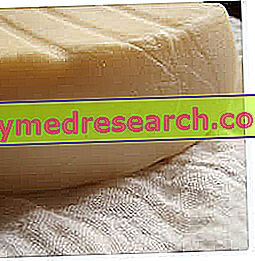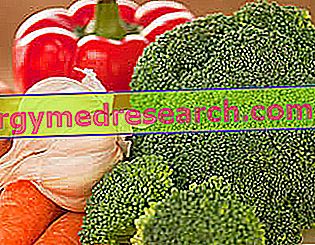In physiology, the term rennet identifies a particular digestive enzyme that works exclusively on milk casein. This enzyme is produced by mammalian infants and puppies in general and targets milk caseins, which break down into smaller protein fragments, aiding digestion.

In the dairy industry, rennet is a fundamental ingredient for the production of many types of cheese . The real (and only) rennet is that of animal origin, which - also known as rennet - is prepared from abomasum of young ruminants, generally calves, lambs or kids. Its function is to make the caseins coagulate, agglomerating them in semisolid precipitates that once drained from the whey and properly processed / seasoned will give rise to the cheese. By analogy of function, the term rennet is commonly (and improperly) extended to other substances with coagulating activity; we speak in particular of vegetable rennet and microbial rennet. In addition to these substances, the simple acidification of the milk (spontaneous through the lactic microorganisms present in milk and / or chemistry) is able to produce a coagulation - albeit milder - of the caseins.
- rennet coagulation: compact and elastic coagulum; coagulation is rapid (less than an hour) and occurs at temperatures close to the optimal rennet ones (35-40 ° C)
- acid coagulation: strongly demineralized and friable rennet; occurs slowly (from 3 to 24 hours) at relatively low temperatures (18-20 ° C)
Naturally the two types of coagulation can be variously combined to obtain products with intermediate characteristics, also exploiting the effect of heat.
In milk, caseins are found in the form of micelles, lipoprotein particles with a tendency to unite and coagulate; under standard conditions this does not happen for two reasons, the first lies in their electrical charge, which at natural pH is negative (negatively charged particles repel each other); the second is related to the presence of the colloidal peptide protector in the C-terminal part of K-casein. The lack of one or both factors determines the coalescence of these particles, hence the protein coagulation.
Animal rennet
It is commercially available in the solid state (dried or freeze-dried powder) or liquid, or in paste; it is commonly available in pharmacies or in dairies for the production of homemade cheeses. Their composition is standardized in order to guarantee a final product of constant quality over time. The rennet in paste is also referred to as " strong rennet " as it has a remarkable coagulating properties (in addition to a lipolytic activity useful in the maturation of some cheeses); there is also a lighter rennet, called " sweet rennet " which is characteristic of powdered calf rennet . More generally, there is a parameter known as the title (or strength) of rennet that expresses the quantity of coagulable milk per rennet unit.
Animal rennet contains mainly two coagulating enzymes: chymosin (or rennin) and pepsin, whose proportions depend on the age of the animal and the type of feeding. The younger the animal and the greater the role of milk in its feeding, the higher the percentages of chymosin are; similarly, the abomasum of an adult bovine will almost exclusively contain pepsin. The most important enzyme of presame is chymosin, which acts by attacking K-casein with hydrolysis between the phenylalanine amino acids at position 105 and methionine at position 106. Peptide fragments are thus obtained which destabilize the internal equilibrium of the casein micelles. which no longer repel each other but aggregate to form the clot.
- NOTE: the rennet coagulant activity is maximum around 40-42 ° C, while it tends to cancel itself below 10-15 ° C and above 55-60 ° C. It is facilitated by acidifying substances (such as citric or tartaric acid: the optimal pH of chymosin is 4.7) and delayed by alkalis. Naturally the activity of the rennet also depends on the concentration of the enzyme; it is also influenced by the degree of pasteurization of milk
| GUY | ORIGIN | FEATURES | CHEESES | |
| Chymosin / trypsin ratio | Generality | |||
| Liquid rennet | Calf | High | It has little influence on the taste of cheeses. Store the rennet in the fridge at 4 ° C | Italian cheeses including many DOP |
| Bovine | Bass | |||
| Rennet in powder form | Calf | High | It has little influence on the taste of cheeses. Store in a dry environment | Most of the French cheeses and many Italians |
| Bovine | Bass | |||
| Rennet in paste | Calf | Contains a modest amount of lipase | It greatly affects the taste of the cheeses. Paste rennets often have a high microbial load | Pecorino Romano, Sicilian Pecorino, Fiore Sardo, Provolone |
| Lamb | Contains a fair amount of lipase | |||
| Kid | Contains a high amount of lipase | |||
Vegetable rennet
The use of vegetable rennet is maintained in the production of some traditional cheeses, both in Italy and in the Iberian peninsula. It is also suitable, unlike rennet, for the production of cheeses suitable for vegetarian subjects (lacto-ovo-vegetarians).
Vegetable rennet is made up of juices from vegetable parts, mainly Cardo and Artichoke. The table shows a list of some vegetable coagulants; we also report the use of pineapple and sunflower extracts.
| Common name | Scientific name |
| Fico Latex | Ficus carica |
| Thistle | Cynara cardunculus sottospecie flavescens |
| Cultivated thistle | Cynara cardunculus sottospecie cardunculus |
| Gallium | Gallium verum |
| Wild artichoke | Carlina acaulis |
| CHEESE | VEGETABLE COAGULANT | REGION OR COUNTRY |
| Casu Perutu | Thistle | Campania |
| Cacio Fiore Aquilano | Artichoke | Abruzzo |
| La Serena | Thistle | Spain |
Video recipe: homemade cheese with vegetable / microbial rennet
Microbial rennet
Food biotechnology aims to select microorganisms with useful characteristics for production processes; specifically the researchers succeeded in isolating and transmitting the gene of animal origin responsible for the production of chymosin. Microbial rennets are used in the production of many types of cheese, except for PDO and typical ones (the use of different types of rennet is regulated by different laws and production regulations).
Homemade Cheese
Cheese - how to prepare it at home
X Problems with video playback? Reload from YouTube Go to Video Page Go to Video Recipes Section Watch the video on youtubeBibliography
- Microbiology and dairy technology. Quality and safety - Di Germano Mucchetti, Erasmo Neviani - New Techniques
- Cheese Atlas - Di Giorgio Ottogalli - Hoepli



